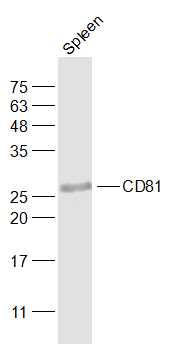![FACS analysis of human peripheral blood using GTX80041-02 CD81 antibody [M38] (Biotin). FACS analysis of human peripheral blood using GTX80041-02 CD81 antibody [M38] (Biotin).](https://www.genetex.com/upload/website/prouct_img/normal/GTX80041-02/GTX80041-02_20191025_AP_006_368_w_23061322_741.webp)
FACS analysis of human peripheral blood using GTX80041-02 CD81 antibody [M38] (Biotin).
CD81 antibody [M38] (Biotin)
GTX80041-02
ApplicationsFlow Cytometry, ImmunoFluorescence, ImmunoPrecipitation, Western Blot, ImmunoCytoChemistry, ImmunoHistoChemistry, ImmunoHistoChemistry Paraffin
Product group Antibodies
ReactivityFeline, Human, Rabbit
TargetCD81
Overview
- SupplierGeneTex
- Product NameCD81 antibody [M38] (Biotin)
- Delivery Days Customer9
- ApplicationsFlow Cytometry, ImmunoFluorescence, ImmunoPrecipitation, Western Blot, ImmunoCytoChemistry, ImmunoHistoChemistry, ImmunoHistoChemistry Paraffin
- CertificationResearch Use Only
- ClonalityMonoclonal
- Clone IDM38
- Concentration1 mg/ml
- ConjugateBiotin
- Gene ID975
- Target nameCD81
- Target descriptionCD81 molecule
- Target synonymsCVID6, S5.7, TAPA1, TSPAN28, CD81 antigen, 26 kDa cell surface protein TAPA-1, CD81 antigen (target of antiproliferative antibody 1), tetraspanin-28, tspan-28
- HostMouse
- IsotypeIgG1
- Protein IDP60033
- Protein NameCD81 antigen
- Scientific DescriptionThe protein encoded by this gene is a member of the transmembrane 4 superfamily, also known as the tetraspanin family. Most of these members are cell-surface proteins that are characterized by the presence of four hydrophobic domains. The proteins mediate signal transduction events that play a role in the regulation of cell development, activation, growth and motility. This encoded protein is a cell surface glycoprotein that is known to complex with integrins. This protein appears to promote muscle cell fusion and support myotube maintenance. Also it may be involved in signal transduction. This gene is localized in the tumor-suppressor gene region and thus it is a candidate gene for malignancies. Two transcript variants encoding different isoforms have been found for this gene. [provided by RefSeq, Jul 2014]
- ReactivityFeline, Human, Rabbit
- Storage Instruction2°C to 8°C
- UNSPSC12352203
References
- He D, Ho SL, Chan HN, et al. Molecular-Recognition-Based DNA Nanodevices for Enhancing the Direct Visualization and Quantification of Single Vesicles of Tumor Exosomes in Plasma Microsamples. Anal Chem. 2019,91(4):2768-2775. doi: 10.1021/acs.analchem.8b04509Read this paper
- Lei P, Sun R, Wang L, et al. A New Method for Xenogeneic Bone Graft Deproteinization: Comparative Study of Radius Defects in a Rabbit Model. PLoS One. 2015,10(12):e0146005. doi: 10.1371/journal.pone.0146005Read this paper




